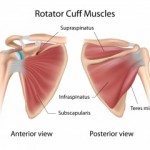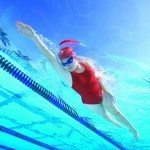As promised, the triathlete series continues. Last month, Swim Part I [1] was posted, emphasizing the importance of scapular stabilization for latissimus dorsi power. The post highlighted how Pilates is highly effective at training scapular awareness, stabilization and strength. This post will concentrate on the role of the rotator cuff and abdominals during the freestyle stroke. And, once again, how Pilates successfully trains these two muscle groups.
There are 4 main phases of the swim stroke: glide, catch, pull-through and recovery. The big power phase of the stroke is pull-through. At early pull-through the arm extends (pulls back), adducts (moves slightly toward body) and internally rotates (turns in)…all of the actions of the latissimus dorsi (lat) discussed in the previous post. Along with the lat, the pectoralis major and serratus anterior are continually active during the pull-through phase. It’s a good thing Pilates addresses the balance of all of these muscles. The last post discussed the importance of keeping the pectoralis group lengthened to decrease inhibition of the scapular stabilizers (i.e. serratus anterior).
In addition, because the elbow is higher than the hand during pull-through, the rotator cuff is kicked on. The biggest issue with the pull-through phase is that it has A LOT of internal rotation. Repetitive internal rotation can cause impingement and a very painful swimmer’s shoulder. Clinically, I’m always trying to avoid this.
What is swimmer’s shoulder? It is a nagging pain in the front of the shoulder that occurs during and/or after the workout. It’s no fun, especially if a training week consists of 10,000 meters of swimming.
What causes swimmer’s shoulder? It can be a variety of issues (i.e. tendonitis, capsule laxity, labral tear, acromion), but I will go back to my stock answer: “If you fix the biomechanics of the stroke, most pain is preventable and/or will eventually resolve.”
So, if the freestyle stroke is dominant with shoulder internal rotation, how does our body control and protect our shoulder from impingement? Two super cool ways.
1. ROTATOR CUFF
 [2]This is a group of 4 muscles: supraspinatus, infraspinatus, subscapularis and teres minor. I call it “the core of the shoulder”. These muscles stabilize the humeral head in the joint and prevent excessive movement. If the rotator cuff isn’t working well, the humeral head (arm bone) is allowed to bang around in the shoulder joint, maybe hitting a bursa or tendon in its path. Ouchy. Not only does the rotator cuff stabilize the arm in the joint, it also controls all of the internal rotation during pull-through. The external rotators act as counter-force to limit the amount of internal rotation and keep the shoulder happy and healthy.
[2]This is a group of 4 muscles: supraspinatus, infraspinatus, subscapularis and teres minor. I call it “the core of the shoulder”. These muscles stabilize the humeral head in the joint and prevent excessive movement. If the rotator cuff isn’t working well, the humeral head (arm bone) is allowed to bang around in the shoulder joint, maybe hitting a bursa or tendon in its path. Ouchy. Not only does the rotator cuff stabilize the arm in the joint, it also controls all of the internal rotation during pull-through. The external rotators act as counter-force to limit the amount of internal rotation and keep the shoulder happy and healthy.
2. TRUNK ROTATION WITH ABDOMINAL ACTIVATION
 [3]This is the other way our body has figured out how to prevent impingement. During the glide, catch and pull-through phases, the arm travels through the water while the trunk rotates AWAY from the arm. This trunk position requires a lot of abdominal stability AND it decreases the amount of internal rotation occurring at the shoulder. Really? How can trunk rotation affect the shoulder?
[3]This is the other way our body has figured out how to prevent impingement. During the glide, catch and pull-through phases, the arm travels through the water while the trunk rotates AWAY from the arm. This trunk position requires a lot of abdominal stability AND it decreases the amount of internal rotation occurring at the shoulder. Really? How can trunk rotation affect the shoulder?
Blog Activity
Face forward and straighten your arm out in front of you at about shoulder height. Notice the angle of your shoulder to your chest, about 90º. Now, leave your arm where it is and rotate your trunk away from it. Notice how the angle from the shoulder and chest increases? This is what allows for decreased impingement. Cool, huh?
The following videos demonstrate some of the exercises I use to strengthen a swim stroke and avoid swimmer’s shoulder.
Kneeling Arm Circles: Core and scapular activation while training the rotator cuff to stabilize the arm in the socket. Although this looks simple, if any of these muscles are not working correctly, you will either fall forward or your arms will simply not move around.
Side sit-ups with long lever stabilization: Core activation in a side-lying position to teach the trunk how to remain stable and strong during the swim stroke. Hardest side sit-ups you’ll ever do is on the Reformer!
Kneeling Arm Series: Side Bend: Excellent movement to train rotator cuff stabilization in an overhead position, while the lat and oblique work hard to pull the strap.
© 2014 and Beyond. ALL BLOG CONTENT at duncansportspt.com by Lori Duncan PT
ABOUT THE AUTHOR
 Lori Duncan, DPT, MTC, CPT is a respected Physical Therapist, Manual Therapist and Pilates instructor in Lafayette, CO. Lori is passionate about preventive physical therapy and education and is a nationally recognized presenter. She can be reached at [email protected]. You can also follow Duncan Sports Therapy + Wellness on Facebook [7] & Instagram [8] for more free tips and information.
Lori Duncan, DPT, MTC, CPT is a respected Physical Therapist, Manual Therapist and Pilates instructor in Lafayette, CO. Lori is passionate about preventive physical therapy and education and is a nationally recognized presenter. She can be reached at [email protected]. You can also follow Duncan Sports Therapy + Wellness on Facebook [7] & Instagram [8] for more free tips and information.
References
Bak, K. The practical management of swimmer’s painful shoulder: etiology, diagnosis, and treatment. Clin J Sport Med. 2010;20(5)386-90.
Heinlein S, Cosgarea A. Biomechanical considerations in the competitive swimmer. Sports Health. 2010;2(6)519-525.
Tovin B. Prevention and treatment of swimmer’s shoulder. N Amer J Sports Med. 2006;1:166-175.